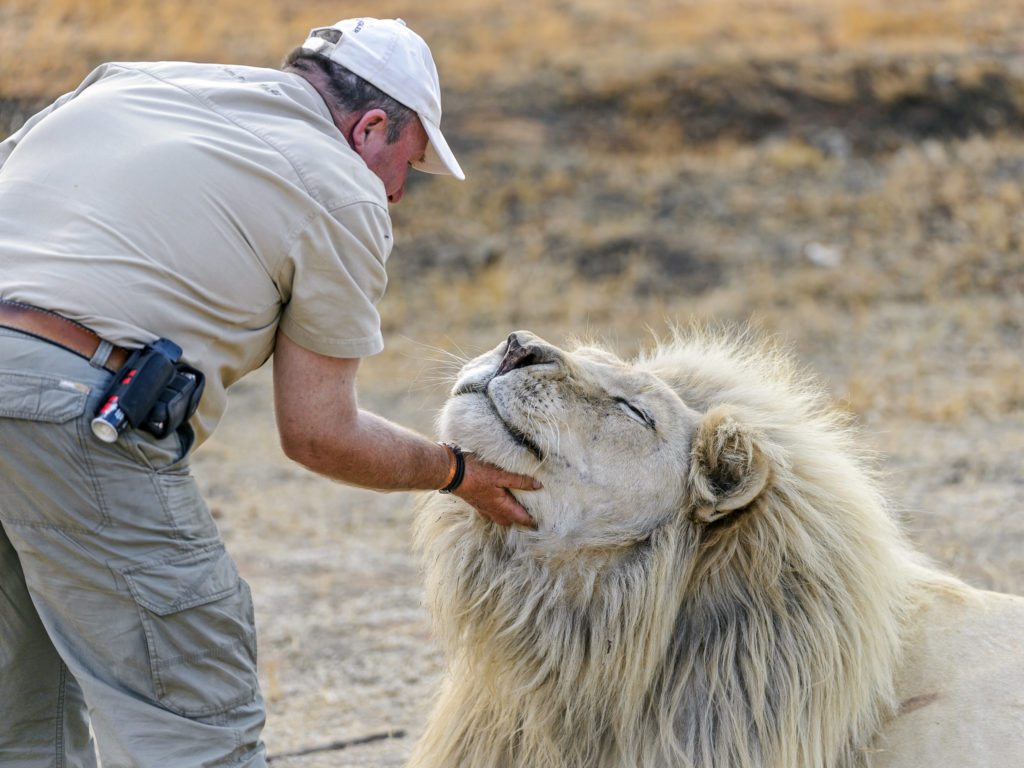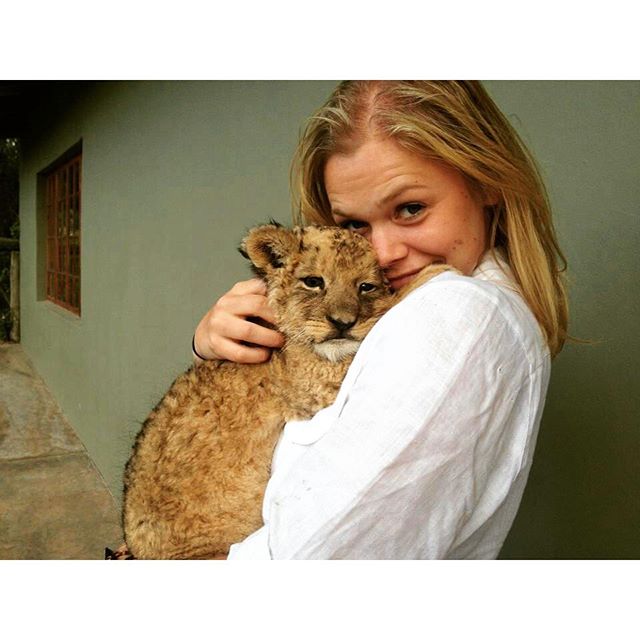Recently, I have seen several posts and stories on social media with humans hugging or playing with wild animals such as lions, minks or even pet monkeys. All the people I see posting this stuff are vegan.
The only ones who reacted with maturity and wisdom to my message against this kind of post were a new team of antispeciesist activists who ultimately decided to delete a video that included a human hugging a lion and wrote a story explaining why they deleted it. And these are the youngest. All the others, people 20 years older, were trying to explain and argue in defense of these posts, giving the impression of people who are living in a parallel universe. This is romanticism at its worst.
Yes, indeed, mink are not here in order for us to breed them and slaughter them for their fur. However this does not mean that they are here for us to pet and hug them.
Yes, indeed, lions can become friends with the humans who rescue them, but if these humans had an ecocentric (instead of egocentric) point of view, they would not pet them or raise them with hugs and cuddles.
Below you can see examples of people who raised lions who eventually attacked them. As a result, the lions were then killed.
In South Africa, three lions were killed after they attacked and killed their owner. In another example, a man was attacked by an adult lion he bottle-fed as a cub.
As Fiona Miles, director of FOUR PAWS animal welfare foundation stated: “These attacks can be avoided by not allowing any unnecessary human-wildlife interaction, and the fact remains that no matter how tame they may seem, lions remain instinctive. The predator’s instinct will seek out certain characteristics and identify easy prey such as the small, weak, slow and sick. What seems to happen with captive animals where interaction is regular is that they reach a breaking point and lash out. About 60% of attacks on humans due to predator interaction involve captive-bred lions.”
By the way, there are three times more lions in captivity than free in nature!
FOUR PAWS is a well known organization among animal lovers. They have rescued so many animals from abandoned zoos in warzones, from illegal owners, from circuses, etc. and then find them sanctuaries to live the rest of their lives. They never treat these animals with a hands-on policy. They could, but they don’t do it. Why? Well, because when you really love wild animals, you don’t want to pet or touch them, you just want to see them experiencing beautiful moments with other individuals of their own species.

To my make myself clear here, please do not think that I am pretending to know everything, nor that this is the way I always thought about animal captivity. On the contrary, in 2006 I went to a dolphinaria in Valencia. Then, in 2009 I participated in an eco-volunteering trip for dolphin & sperm whale observation, and at that point, the people of Pelagos Cetacean Institute opened my eyes. They explained that dolphins suffer in captivity. Now, on the homepage of my website Ethos & Empathy, you can watch a TV spot against the captivity of dolphins and other wild animals, which I helped coordinate the production of.
Later on, in 2008, I volunteered for 3 whole months at a zoo near Athens. There, during my volunteer experience, I hugged baby pumas, who were bottle-fed by humans because their mother did not have milk (at least this is what I was told). I was even “forced” to pet a wild feline who arrived at the park some time before my resignation, because as one member of their staff claimed, “it has been trained to receive caresses, it will sit.” And indeed he sat, but I felt disgusted with myself at that very moment because I could see the hatred in his eyes. I saw how much he did not want to receive caresses. At this zoo there was also an otter who liked to play with humans very much. I entered the cages of wolves, lynx, and monkeys and hand fed them. I even pet the male lion.
This was an experience that I started out considering super cool. I had the popular mindset of “zoos are conserving biodiversity.” And then I woke up and left, because I realized that nothing is as it seems in zoos, and that if they indeed cared for the animals, they would not sell tickets. Ever since I left, I am on their blacklist, and they consider me the crazy ex-volunteer who lost her mind and went vegetarian. Imagine how extreme they would think it is that I’ve since gone vegan!
Later on I went to volunteer at MO-m monk seal rescue center in Alonissos, Greece, which unfortunately has since been transferred to the premises of the aforementioned zoo. There I was told that I was not allowed to touch the baby seal, and that only two people were allowed to touch her, so that she would not get used to humans. Then I understood. At that point I realized what an egoist I had been, how selfish it is to have the will to touch all animals. How human-centered is our way of thinking.
Likewise, when I went in Holland to work as a volunteer for 5 months at Stichting AAP, a primate and small mammal rescue center, I never touched any animal. Even when I entered their enclosure, I was not in contact with them. The protocol was strict: we would first close the hatch connecting the two enclosures, and then enter the side where no animals were located in order to clean and leave their food. In fact, this was one of the questions during my interview: whether I was aware of the hands-off policy and why is it so important.
The same organization has one more sanctuary in Spain, for felines who are confiscated from circuses or from closed down zoos. At this sanctuary they don’t pet or hug the animals either. There is no contact with wild animals. Many of these animals have even grown up in the arms of a human, but this is not a reason to perpetuate that mistake.

I would like you to know that some animals who have been raised by humans take months, or even years, to get used to others of their own species and stop seeking human attention. This is very sad.
Finally, I would like to mention one different story, which does not include captivity or petting wild animals. It is a case of an unstable personality who was obsessed with wild animals and wanted to live among them, but at the end he paid for this with his own life.
I am referring to the case of Timothy Treadwell, a man from the United States who lived among grizzly bears in Alaska. He spent 13 summers with them. An audio recording of his last moments has been published and it’s horrifying. A 28 year old bear killed and partially ate Treadwell and his girlfriend. Of course, authorities killed the bear in order to find the remains. They also killed a younger bear who happened to be in the area, but this second bear’s body was eaten by other animals so the authorities were unable to check if she also was “guilty” for their deaths. Throughout the history of Katmai National Park, where the event occurred, this is the only known case of bear killing a human.
Now, take some time please to think about it. Whose fault was this? The bears or the humans? We are talking about a man who was going to schools to educate children for the best interest of bears so that locals could live in harmony with them…but the way he tried to do so was totally wrong.
The worst part of these stories is the poor animals’ horrible endings after reacting naturally. I mean, who gave humans the right to kill them for acting on instinct? Do you realize the madness?
Treadwell had stated that he felt better among bears and rejected the modern world. Well, let me tell you that I have also rejected a modern life, I live in isolated villages with very few inhabitants and I feel better when I walk in the forest with my dogs, but I would never go live among wolves or go bother brown bears (who are the focus of my thesis, by the way).
So, I don’t understand why some adult vegans stubbornly refuse to comprehend that it’s wrong to encourage people to have a hands-on relationship with wild animals.
Can we be humble enough to accept our mistakes? This would not be such a catastrophe. A willingness to change and learn from mistakes is actually is a sign of maturity, not a sign of weakness. We we will always continue to be educated throughout our lives. We often receive new information, which can make us feel uncomfortable. Let’s take advantage of these opportunities in order to become better people, instead of getting stuck in our old mindsets.
We once realized that we were eating animals who had feelings and rights, and stopped doing it because we understood that this was not aligned with our values. We can also realize that we have promoted images and videos which seem to be superficially cute but are actually inherently wrong. It’s time to stop doing this.
I suppose that common sense is not so common at the end of the day though…
This piece was originally posted on the Ethos & Empathy website.
Featured image: a (paying) volunteer in a voluntourism program plays with a baby panda. Reputable programs and facilities do not allow this kind of contact. Image credit Frontierofficial, CC BY-SA 2.0.





